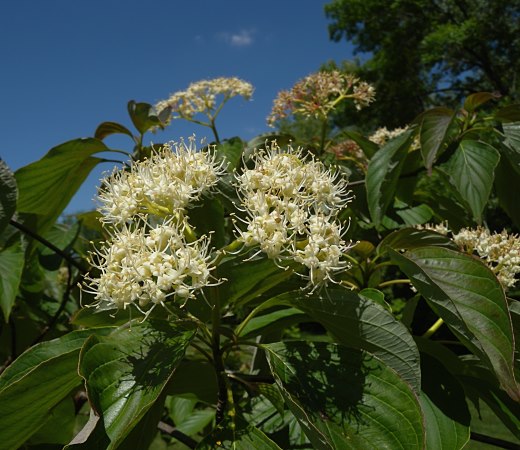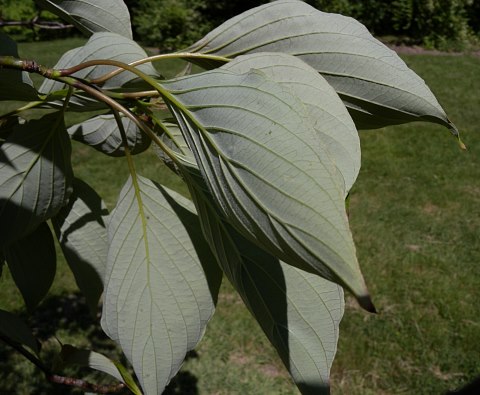Description: This shrub is up to 25' tall, developing widely spreading branches that are often arranged in tiers. The trunk bark of older shrubs is light brown and slightly rough; it has furrows that are shallow and narrow. The trunk bark of younger shrubs is more smooth and pale greenish brown. Alternate leaves are located toward the tips of small branches and twigs; they are spaced closely together, sometimes appearing opposite or whorled.

The leaf blades are 2-5" long and about one-half as much across; they are ovate in shape and smooth along their margins. The upper leaf surfaces are medium to dark green and glabrous, while their lower surfaces are pale green to white and canescent (very short fine hairs). Leaf venation is pinnate; for each leaf blade, there are 5-6 curving lateral veins on each side of the central vein. The slender petioles of the leaves are light green to red and up to 1" long. Flat-headed panicles of flowers are produced from among the leaves. Each panicle spans about 2–3½" across and contains numerous small flowers that are cream-colored to white. Each flower is about ¼" across, consisting of a 4 narrowly lanceolate petals, a tiny calyx, 4 stamens, and a central style. The petals spread widely from the center of each flower, drooping downward somewhat later. During the blooming period, the branches of the panicle are light green. The blooming period occurs from late spring to early summer and lasts about about 2-3 weeks. The flowers have a pleasant fragrance. The flowers are replaced by small drupes about 1/3" across that become ripe during the early fall. At this time, the drupes are dark blue and the branches of the panicle are orange-red. Each fleshy drupe contains a single large seed (or sometimes two). Ripe berries are sour and bitter. The root system is woody and branching. This shrub reproduces by reseeding itself.
Cultivation: This shrub prefers partial sun, moist well-drained conditions, and a rich loamy soil that is somewhat acidic. It also adapts to full sun and light shade. Growth and development is rather slow.
Range & Habitat: Alternate-Leaved Dogwood is found mostly in the northern half of Illinois, where it is uncommon. In the southern half of the state, it is rare or absent. This shrub is native to the state. Habitats include mesic deciduous woodlands, mixed woodlands (both coniferous & deciduous trees are present), woodland borders and openings, thickets, and shaded or partially shaded banks of streams. This shrub is normally found in high quality natural areas. It is often cultivated as an ornamental landscape plant.
Faunal Associations: The nectar and pollen of the flowers of Alternate-leaved Dogwood attract many kinds of insects, including honeybees, bumblebees, Halictid bees, Andrenid bees, ants, wasps (Ancistrocerus spp.), Syrphid flies, adult long-horned beetles, and other beetles (Lovell, 1898; Lovell, 1915; Wilhelm & Rericha, 2017). The short-tongued bee, Andrena fragilis, is an oligolectic visitor of the flowers. The bees suck nectar and collect pollen, wasps and ants suck nectar only (the latter is non-pollinating), flies suck nectar or feed on pollen, while beetles suck nectar, feed on pollen, or gnaw on floral tissue. Other insects feed destructively by boring through the wood, sucking the plant sap, feeding on the foliage, and other parts of this shrub or small tree. These insects include the larvae of long-horned beetles, weevils, leaf beetles, larvae of gall flies, plant bugs, aphids, leafhoppers, armored scales, mealybugs, larvae of sawflies, larvae of many kinds of moths, and thrips. The larvae of a butterfly, Celastrina ladon (Spring Azure), feed on the flowers and their buds. A more complete list of these insect feeders can be found in the Insect Table. The fruits of Alternate-leaved Dogwood are a very popular source of food for birds, such as Bobwhite Quail, Ruffed Grouse, Wild Turkey, woodpeckers, thrushes, vireos, and some sparrows. The extinct Ectopistes migratorius (Passenger Pigeon) also fed on the fruits of this shrub or small tree at one time. Many of these birds also use Alternate-leaved Dogwood for nesting sites and protective cover. The Bird Table has a more complete list of these species. Among mammals, White-tailed Deer browse on the foliage and twigs, the Cottontail Rabbit gnaws on the bark during the winter, the White-footed Mouse and Fox Squirrel feed on fruits and/or seeds, and the American Black Bear feeds on the fruits of Cornus spp. (Dogwoods); see Martin et al. (1951/1961) and Noyce & Coy (1990).
Photographic Location: Meadowbrook Park in Urbana, Illinois.

Comments: A well-developed specimen of this attractive shrub has branches that are arranged in horizontal tiers, somewhat resembling the multiple roofs of a pagoda. As a result, it is sometimes referred to as the 'Pagoda Dogwood.' This is the only Cornus sp. (Dogwood) in Illinois that has alternate leaves; others species in this genus have opposite leaves. Alternate-Leaved Dogwood has 5-6 conspicuous lateral veins on each side of the central vein of a leaf; the leaves of other Dogwood species usually have fewer lateral veins that are less conspicuous. The color of the ripe berries is also useful in making an accurate identification, as Alternate-Leaved Dogwood has dark blue berries, while other Dogwood species in Illinois usually have berries that are white, red, or pale to medium blue.